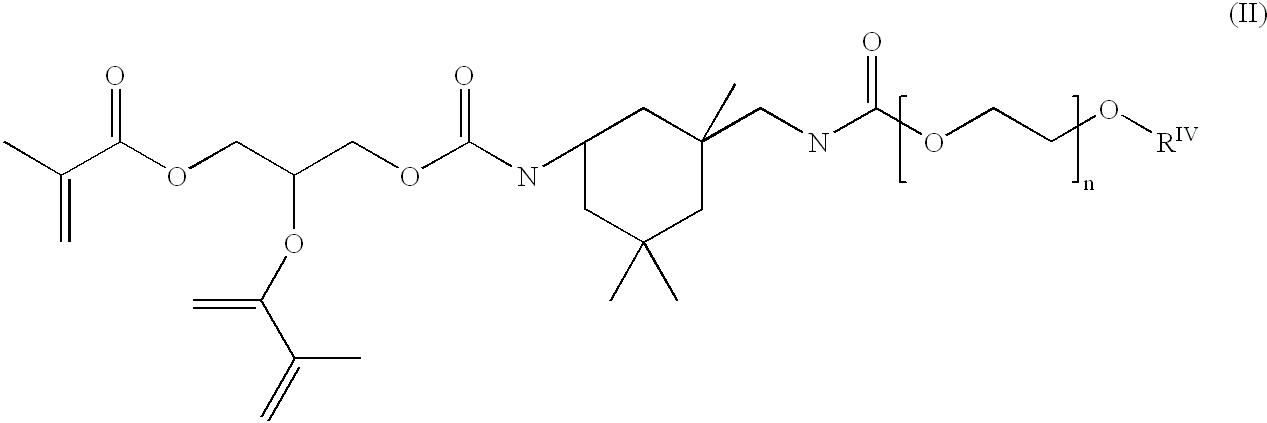Self etching adhesive primer composition and polymerizable surfactants
a technology of adhesive primer and composition, applied in the field of self-etching adhesive primer composition and polymerizable surfactants, can solve the problems of undesirable physical characteristics, weak spongy polymers, and still requires considerable time and skill on the part of the dentist, and achieve the effect of keeping the suspension stabl
- Summary
- Abstract
- Description
- Claims
- Application Information
AI Technical Summary
Benefits of technology
Problems solved by technology
Method used
Image
Examples
example 2
5.6 grams Isophoronediisocyanate was stirred with 50 grams polyethylene glycol monomethylether 2000 (mean molecular weight 2000) and warmed to about 60.degree. C. until the PEGME melted. 0.25 grams Dibutyl tin dilaurate was added and the mixture stirred further. A clear liquid was formed which solidified on cooling. This was warmed again to 65.degree. C., 0.05 grams of BHT was added, followed by adding 5.7 grams of glycerine dimethacrylate. The mixture was heated to 90.degree. C. and stirred for about 2 hours, after which an FTIR showed that all the isocyanate had been consumed. The product was a white hard waxy solid, partially soluble in water to give a light foam on shaking. The material had a melting range of about 49-51.degree. C. The HLB value is calculated to be approximately 16.
PREPARATION OF SURFACTANT G5000.
example 3
The method of Example 2 was repeated except for the amount of each component, 75 grams polyethylene glycol monomethyl ether with a mean molecular weight of about 5000 was used, together with 3.33 grams of isophorone diisocyanate, 0.1 gram of dibutyl tin dilaurate. After completion of this first reaction, 3.5 grams glycerol dimethacrylate and 0.05 grams BHT were added. As in example 2, the mixture was stirred at 90.degree. C. for about 2 hours after which the reaction was complete. The polymerizable surfactant (G5000) product was a hard waxy solid, partially soluble in water to give a light foam on shaking. The material had a melting range of about 58-60.degree. C. The HLB value was calculated to be approximately 18.
PREPARATION OF SURFACTANT HP2000
example 4
5.6 grams Isophorone diisocyanate and 50 grams polyethylene glycol monomethyl ether 2000 were put in a flask and warmed together at 60.degree. C. until homogenous. 0.25 grams dibutyl tin dilaurate was then added and the mixture stirred and heated at 65.degree. C. for 5 hours. After this time an FTIR showed that the --OH groups of the polyethyleneglycol monomethyl ether had totally reacted. 3.6 grams hydroxypropylmethacrylate and 0.05 grams BHT were added and the mixture stirred approximately one hour. After this time an FTIR spectrum showed that the --OH of the hydroxypropylmethacrylate and the NCO group had totally reacted. A polymerizable surfactant (HP2000) product, as a white waxy solid, was obtained which had a melting range of 50-52.degree. C. The HLB value was calculated to be approximately 17.
PREPARATION OF SURFACTANT HP750
PUM
| Property | Measurement | Unit |
|---|---|---|
| Length | aaaaa | aaaaa |
| Time | aaaaa | aaaaa |
| Length | aaaaa | aaaaa |
Abstract
Description
Claims
Application Information
 Login to View More
Login to View More - R&D
- Intellectual Property
- Life Sciences
- Materials
- Tech Scout
- Unparalleled Data Quality
- Higher Quality Content
- 60% Fewer Hallucinations
Browse by: Latest US Patents, China's latest patents, Technical Efficacy Thesaurus, Application Domain, Technology Topic, Popular Technical Reports.
© 2025 PatSnap. All rights reserved.Legal|Privacy policy|Modern Slavery Act Transparency Statement|Sitemap|About US| Contact US: help@patsnap.com



